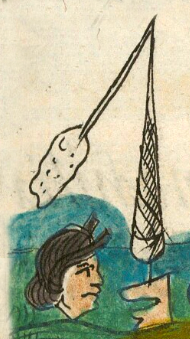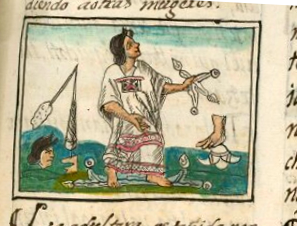tetzauhcihuatl (FCbk10f40r)
This colorful compound glyph for the term tetzauhcihuatl (called a “scandalous woman” or an “adultress” in the Western perspective), is included in this digital collection for the purpose of making comparisons with other hieroglyphs and iconographic examples. The term selected for this example comes from the text on the same page in the Digital Florentine Codex. There is no gloss, per se. This compound includes a vertical drop spindle (malacatl), loaded with thread or yarn. It recalls a spinner (tzauhqui), and therefore serves as a phonetic indicator for the middle part of this term. The spindle stands on a pair of lips (tentli) which is another phonetic indicator for the start (te-) of the term. Finally, in the lower left is the head of a woman (cihuatl), providing both the third part of the term, more semantic than phonetic. The contextualizing image includes the woman who is referenced by the term tetzauhcihuatl. Like the ahuiani, she is dressed nicely and she stands on and holds water in her hand. Her hair is properly styled. Her huipil has an extra nice chest patch, where the tlacuilo took time to show its X-shape design and some shaggy fibers running along the top of the patch. The bottom of the huipil also has what appear to be beads or water droplets.
Stephanie Wood
One has no way of knowing just how much the negative descriptions of the tetzauhcihuatl are influenced by the colonial clergy. A study of the etymology of the term might help one understand its original meaning. One might start by investigating tetzahuatl (a swirling river or a marvel), tetzahua (to thicken or become firm) and tetzahuac (something thick or hardened). Perhaps surprisingly, this collection includes Tetzauhcihuatl as a man’s name (see below). Perhaps, despite the “cihuatl” element, the term Tetzauhcihuatl could refer to a man who was unfaithful in a relationship.
Stephanie Wood
Tetzauhcioatl
tetzauhcihuatl
Stephanie Wood
1577
Jeff Haskett-Wood
scandalous, scandal, mujer escandalosa, parejas, moralidad, religión cristiana

tetzauhcihua(tl), a scandalous woman (in Western perspective, certainly), https://nahuatl.wired-humanities.org/content/tetzauhcihuatl
la adúltera
Stephanie Wood
Available at Digital Florentine Codex/Códice Florentino Digital, edited by Kim N. Richter and Alicia Maria Houtrouw, "Book 10: The People", fol. 40r, Getty Research Institute, 2023. https://florentinecodex.getty.edu/en/book/10/folio/40r/images/0 Accessed 10 September 2025.
Images of the digitized Florentine Codex are made available under the following Creative Commons license: CC BY-NC-ND (Attribution-NonCommercial-NoDerivs 4.0 International). For print-publication quality photos, please contact the Biblioteca Medicea Laurenziana ([email protected]). The Library of Congress has also published this manuscript, using the images of the World Digital Library copy. “The Library of Congress is unaware of any copyright or other restrictions in the World Digital Library Collection. Absent any such restrictions, these materials are free to use and reuse.”



